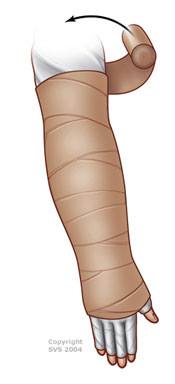Lymphedema
Lymphedema occurs when your lymph vessels are unable to adequately drain lymph fluid, usually from an arm or leg but you can develop edema can develop nearly anywhere on the body. Lymphedema can be either primary or secondary. This means it can occur on its own (primary or congenital lymphedema) or it can be caused by another disease or condition (secondary lymphedema). Secondary lymphedema is far more common than primary lymphedema.
Causes of secondary lymphedema
Any condition or procedure that damages your lymph nodes or lymph vessels can cause lymphedema. Causes include:
- Surgery. Lymphedema can develop if your lymph nodes and lymph vessels are removed or cut. For instance, surgery for breast cancer may include the removal of one or more lymph nodes in your armpit to look for evidence that cancer has spread. If your remaining lymph nodes and lymph vessels can't compensate for those that have been removed, lymphedema may develop in your arm.
- Radiation treatment for cancer. Radiation can cause scarring and inflammation of your lymph nodes or lymph vessels, restricting flow of lymph fluid.
- Cancer. If cancer cells block lymphatic vessels, lymphedema may result. For instance, a tumor growing near a lymph node or lymph vessel could become large enough to block the flow of the lymph fluid.
- Infection. An infection of the lymph nodes can restrict the flow of lymph fluid and cause lymphedema. Parasites also can block lymph vessels. Infection-related lymphedema is most common in tropical and subtropical regions of the globe and is more likely to occur in developing countries.
Causes of primary lymphedema
Primary lymphedema is a rare, inherited condition caused by problems with the development of lymph vessels in your body. Primary lymphedema occurs most frequently in women. Specific causes of primary lymphedema include:
- Milroy's disease (congenital lymphedema). This is an inherited disorder that begins in infancy and causes your lymph nodes to form abnormally, leading to lymphedema.
- Meige's disease (lymphedema praecox). This hereditary disorder often causes lymphedema in childhood or around puberty, though it can occur in your 20s or early 30s. It causes your lymph vessels to form without the valves that keep lymph fluid from flowing backward, making it difficult for your body to properly drain the lymph fluid from your limbs.
- Late-onset lymphedema (lymphedema tarda). This occurs rarely and usually begins after age 35.

How the Lymphatic System Works
Your lymphatic system is crucial to keeping your body healthy. It circulates protein-rich lymph fluid throughout your body, collecting bacteria, viruses, and waste products. Your lymphatic system carries this fluid and any harmful substances through your lymph vessels and into your lymph nodes. There the wastes are then filtered out by lymphocytes — infection-fighting cells that live in your lymph nodes — and ultimately flushed from your body.
How is Lymphedema Treated
Primary and secondary lymphedema are treated virtually the same way.
- Manual Lymphatic Drainage (MLD). This type of gentle hands-on therapy is intended to encourage the natural drainage of lymph fluid, which carries waste products away from the tissues back toward the circulatory system to eventually be processed out of the body in via the kidneys.
Click here for more information about MLD. - Short Stretch Compression Bandaging. Using very specific bandages, compressive padding and gauze or other compressive materials to wrap the areas effected by edema. This specific type of compression encourages excess fluid to leave the area via the “path of least resistance”- allowing for significant reductions in the size of the limb or area of swelling. This is done on a daily basis (at least 5 or 6 times a week) for approximately 2-3 weeks depending on the needs of the individual.
- Compression Garments. The best, long term way to prevent lymphedema from returning to an area of the body is practicing consistent use of compression garments. For many people, once they develop lymphedema, it is something they will deal with chronically. Daily use of garments that help reduce the body’s tendency to “back fill” into areas that are prone to edema, keep the tissue healthy and the affected area comfortable.
- Exercise and Self-Care. A good Combined Decongestive Therapy program will make certain to provide you the skills and the knowledge needed to manage your lymphedema independently. You should learn how to bandage yourself, care for YOUR skin, confidently use exercises that will help reduce your swelling, apply kinesio tape to trouble areas, and understand how to use a pneumatic compression system.
Examples of hand and foot bandaging for lymphedema.

